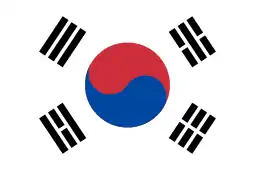Korean Brazilians
Korean Brazilians (Portuguese: Coreano-brasileiro, Korean: 한국계 브라질인 or 韓國系 브라질人) are Brazilians of full, partial or predominantly Korean ancestry or a Korean-born person residing in Brazil. The Korean population in Brazil, the largest in Latin America, is about 50,000.[4]
Coreano-brasileiro 한국계 브라질인 | |
|---|---|
| Total population | |
| 51,550[1] | |
| Regions with significant populations | |
| Foz do Iguaçu and São Paulo City | |
| Languages | |
| Portuguese and Korean | |
| Religion | |
| Protestantism, Catholicism, Buddhism[2][3] | |
| Related ethnic groups | |
| Other Korean and Brazilian people, Korean Americans and other Asian Brazilians |
History
Korean immigration to South America began on a small scale in the mid-1950s but was only formalized in 1962, when, to encourage emigration to control population, reduce unemployment and garner foreign exchange via immigrant remittances, the South Korean government passed its Overseas Emigration Law. In December 1962, the South Korean Ministry of Public Health and Social Affairs, to which the emigration section was attached, sent 92 people (members of seventeen families) to Brazil. Although the South Korean government's desire to direct emigrants to the Southern Hemisphere was based on the size of the Brazilian economy, many Koreans were hindered by the Brazilian government's demand that all visas, including those for tourists, be preapproved.
Life in Brazil
There has been a large flow of undocumented Korean migrants from Paraguay to Brazil. In 1992, the South Korean embassy in Brazil extrapolated a population of about 40,000, based on families registered at its various consulates in Brazil. This sample may be underrepresenting the numbers significantly, since both documented and especially undocumented immigrants may choose not to register with South Korean diplomatic missions in Brazil. Unofficial estimates put the Korean population of Brazil at between two and three times that of the embassy. The overwhelming majority (90 percent)[5] of Korean immigrants live in São Paulo, where they have created some 2,500 small businesses, most of which are home businesses produce textiles and clothing. Koreans are believed to control two-thirds of the clothing retail business, and their materials travel all over Brazil. Some Koreans also work in the field of electronic engineering and in the export-import trade. In São Paulo, the majority of Koreans live either in Liberdade neighborhood, the traditional Japanese neighborhood; in Bom Retiro, a traditional immigrant neighborhood most recently populated by East European Jews and the Lebanese; in Brás, the former Italian neighborhood, and in the upper-middle-class neighborhood of Aclimação where 30% of the area's resident population is made up of Korean or of Korean origin. The Praça General Polidoro square in Aclimação is surrounded by Korean restaurants, churches and other businesses.
On 6 January 2010, per Municipal Law nº 15100, the São Paulo City Council officially recognised Bom Retiro as the Korean cultural neighbourhood.[6]
In terms of religion, the vast majority of Korean Brazilians are Protestant, with a minority of Catholics.[2][7] There are more Korean churches than Korean restaurants in the Korean Brazilian community.[7] There are also three Buddhist temples located in Korean communities in Brazil, which also attract non-Korean worshippers.[3]
Return to South Korea
The return migration of Korean Brazilians has been closely related to the economic transformation of the Korean community in Brazil and the history of Korean immigration into Brazil since 1963. Most Koreans decided to stay in São Paulo, where they could seek out profitable businesses and build a strong ethnic community in the city. Since the late 1980s, the economic situations of Koreans in Brazil have slowly deteriorated. Many successful Koreans who accumulated sufficient wealth abandoned Brazil to look for economic opportunities elsewhere. Some non-affluent Koreans who failed to adjust to Brazilian society also did not find bright futures in Brazil. Some Korean immigrants in Brazil decided to return to their homeland, the economy of which has grown much faster than Brazil's since the 1980s. The early Korean immigrants who migrated as family units maintained strong ethnic consciousness. Thus, they were able to adapt to South Korean society relatively easily when they returned to the country. Young Korean Brazilians who completed basic South Korean education in South Korea[8] before moving to Brazil also did not encounter any difficulty in maintaining their Korean identity while living in Brazil thanks to the flexibility of Brazilian ethnic relations. However, second-generation Korean Brazilians did not develop clear ethnic identities in Brazil and had to work hard to integrate into Korean society.
Education
Colégio Polilogos (브라질한국학교), a South Korean international school, is located in Bom Retiro, São Paulo.[9][10]
Notable persons
- Angela Park, LPGA golfer
- Francisco Hyun-sol Kim, professional footballer
- Chyung Eun-ju, beauty pageant titleholder, model, student and TV presenter
- Catharina Choi Nunes, Miss Korea 2013 2nd runner-up, Miss Earth Fire 2013, Miss World Brazil 2015
- Iara Lee, filmmaker
- Jung Mo Sung, liberation theologian
- Yoo Na Kim, journalist, writer
References
- 재외동포현황, South Korea: Ministry of Foreign Affairs and Trade, 2009, archived from the original on 2010-10-23, retrieved 2009-05-21
- Park, Kye-young, ed. (2009), "The Second Generation of Koreans in Brazil: A Portrait", The Korean Immigration in the Americas (PDF), UCLA Center for Korean Studies, retrieved 2013-03-10
- Korean Buddhist congregations in Brazil
- Latin American Scholars Meet o, UCLA International Institute
- Asians in South America
- Prefeitura da Cidade de São Paulo. , "Pesquisa de Legislação Municipal Nº 15100", retrieved 14 January 2014
- Joo, Jong-Taick (2010), "Culture and Ethnicity in the Korean Transnational Community in Brazil" (PDF), Iberoamerica, 12 (2): 323–356, retrieved 2013-03-10
- ::: Welcome to KOREA JOURNAL ::: Archived 2011-06-14 at the Wayback Machine
- Home page Archived 2015-09-18 at the Wayback Machine. Colégio Polilogos (브라질한국학교). Retrieved on 21 September 2015. "Rua Solon, 1018 - Bom Retiro São Paulo - SP"
- "Korean School Infomation [sic] - 브라질한국학교." Overseas Korean Educational Institutions. October 2, 2006. Retrieved on September 21, 2015.
